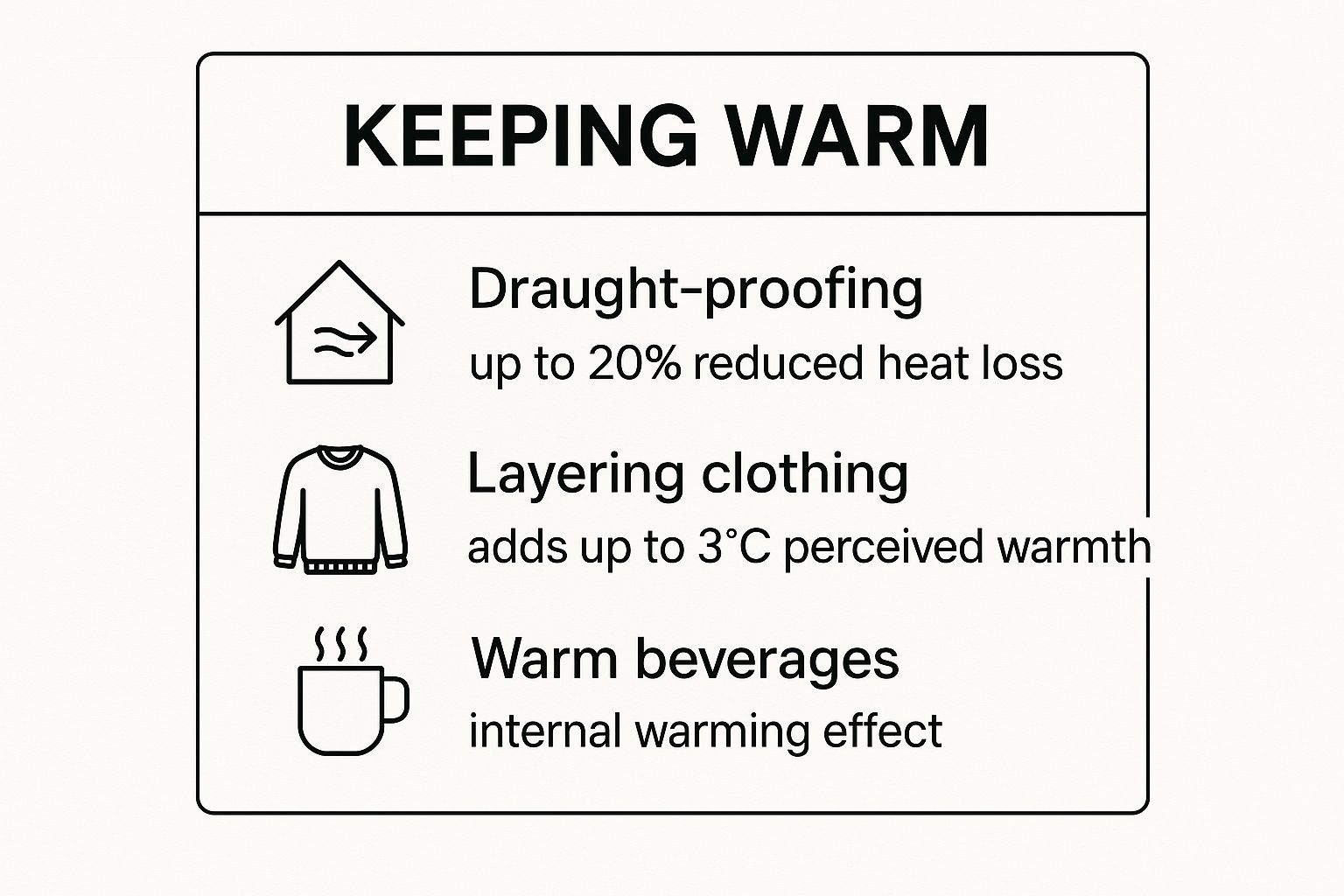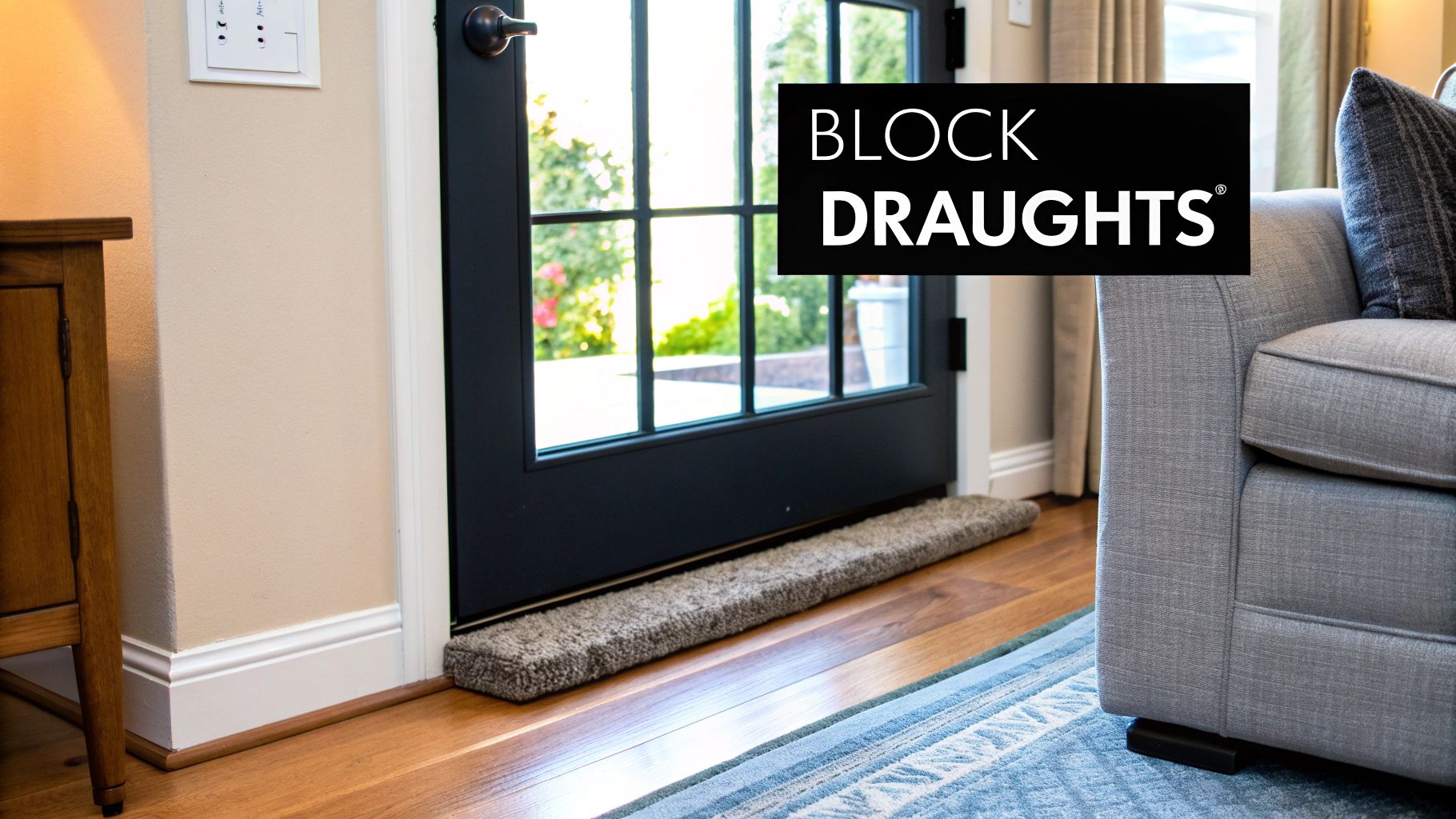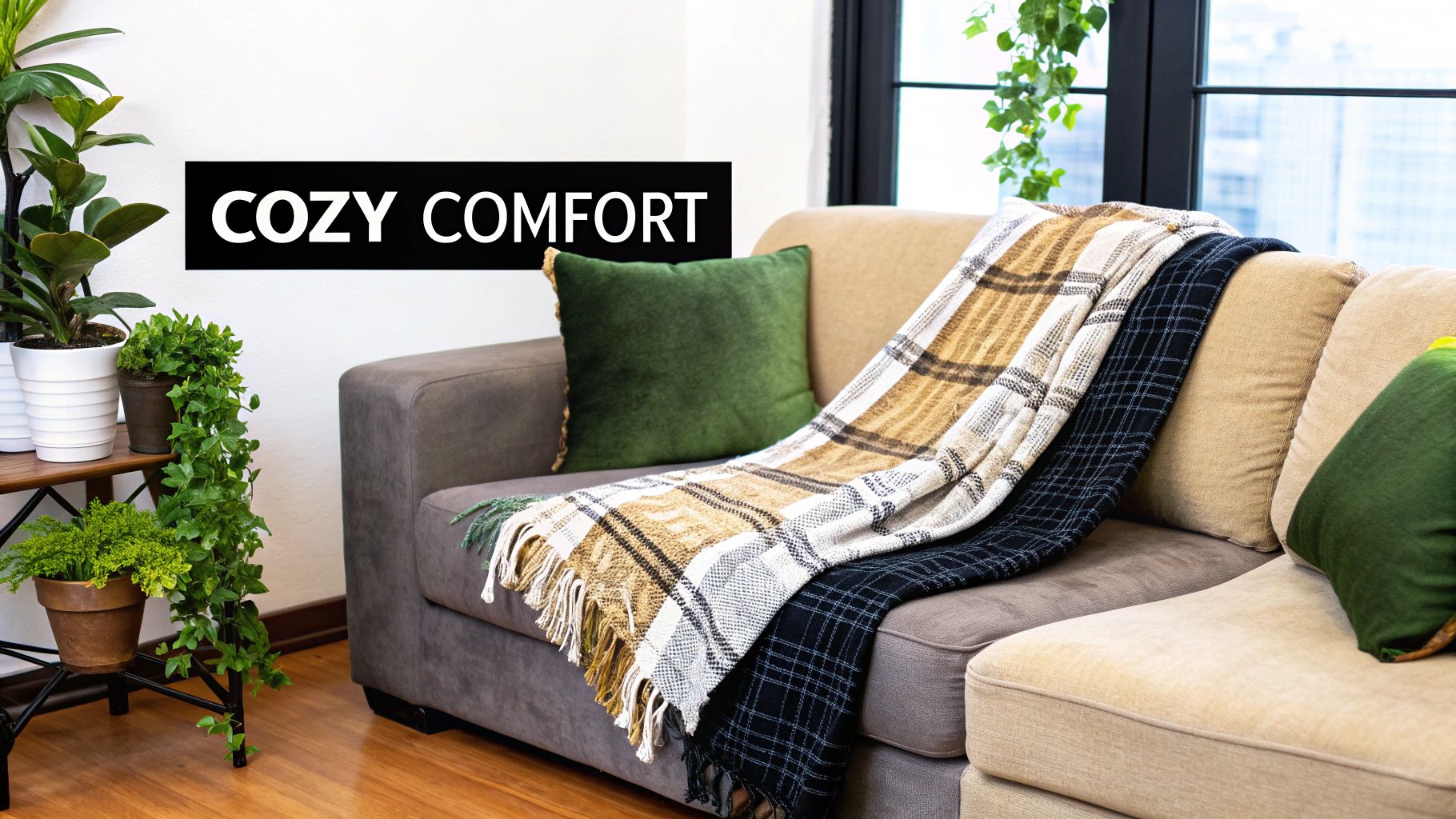Figuring out how to keep warm without turning on the central heating isn't about roughing it. It’s about being clever with your space and your habits.
Essentially, you are focusing on two things. First, keeping the heat you already have inside, and second, making sure your body stays toasty. Simple things like layering your clothes properly or sipping a hot drink can make a world of difference. The aim is to create a genuinely cosy environment, not just tolerate the cold.
Your Guide to a Warmer Home Without Heating
As soon as there's a chill in the air, it is tempting to turn up the thermostat. But with energy prices being what they are, finding smarter ways to stay warm is on everyone's mind. The good news is, you can create a warm, inviting home by focusing on retaining heat, rather than constantly producing more of it.
This guide will give you some of the most effective strategies to get started with right away. We will look at the essentials, such as:
- Hunting down and blocking those sneaky draughts.
- Mastering the art of layering clothes for personal warmth.
- Using your curtains and rugs as extra insulation.
- Making the most of the heat from cooking and other daily activities.
Think of it as your toolkit for a more comfortable and cost effective winter. For an even closer look at these techniques, we have got some fantastic advice in our journal post on how to stay warm in winter.
Sometimes, a quick visual is the best way to see what works. This infographic breaks down the impact of three simple, yet powerful, strategies.

It is amazing what a difference the small things make. Just look at draught proofing. It can prevent up to 20% of your home's heat from escaping. That shows just how much impact you can have on your own comfort levels.
At a Glance Warmth Strategies
To give you a quick overview, here is a breakdown of the most effective ways to keep warm, comparing the effort they take with how much warmer you will feel.
| Strategy | Effort Level | Warmth Impact |
|---|---|---|
| Layering Clothing | Low | High |
| Blocking Draughts | Low | High |
| Using Thick Curtains & Rugs | Low | Medium |
| Drinking Hot Beverages | Low | Medium |
| Closing Unused Rooms | Low | Medium |
| Moving Furniture | Medium | Medium |
As you can see, the highest impact strategies often require the least amount of effort. It is all about working smarter, not harder, to create a comfortable living space.
Creating a Draught Proof and Cosy Home
Your home should be your sanctuary from the cold, and making it feel warm and inviting does not have to mean turning up the thermostat. With a few practical, DIY friendly tweaks, you can make a huge difference to how your space retains heat, often with very little cost or effort. The biggest enemy of a warm room is an invisible one, the draught.
These sneaky streams of cold air can creep in from the most unlikely places. Your first mission is to hunt them down. A great way to do this is to pick a windy day, light a candle or an incense stick, and carefully trace it along your window frames, doors, and even your letterbox. See where the flame or smoke flickers? That is where precious warmth is escaping.
Tackling Common Draught Hotspots
Once you have identified the weak spots, it is time to take action. Thankfully, most of the solutions are incredibly straightforward and available at any local DIY shop.
- Windows: Grab some self adhesive foam strips. They are a brilliant, easy to apply fix for sealing the gaps that often form around window frames, creating a much snugger fit.
- Doors: The classic draught excluder at the bottom of your front and back doors is a classic for a reason. It is a simple, physical barrier that stops cold air from sweeping across your floors.
- Letterboxes: A brush style letterbox cover is a small change that makes a big difference, stopping the wind from whistling through and keeping your hallway much more comfortable.
These little fixes really do add up, preventing significant heat loss and making your home feel noticeably warmer. Improving home insulation is one of the most effective strategies for staying warm without central heating. It is a national priority, too. Government backed schemes have helped install around 4.5 million energy efficiency measures across Great Britain since 2013, highlighting just how impactful these changes can be.
Clever Use of Furnishings
Beyond plugging the gaps, the way you arrange your furniture and use soft furnishings can also help trap warmth. Think of it as adding layers to your home, just as you would with your clothing.
Windows are notorious for letting heat escape, but the right curtains can be your best defence. Heavy, thermal lined curtains are fantastic insulators, trapping a layer of air between the fabric and the cold glass. Just getting into the habit of drawing them as soon as dusk falls can instantly change a room's temperature.

It is also worth taking a look at where your furniture is placed. Is your favourite sofa pushed right up against an external wall? You are probably feeling the cold seep through. Pulling it away even a few inches creates an insulating air gap. For more inspiration on arranging your space for both style and comfort, have a look at our guide on apartment bedroom decorating ideas.
And finally, if you have wooden or tiled floors, laying down a thick rug is one of the quickest and most effective ways to make a room feel warmer underfoot and stop heat from disappearing through the floorboards.
Mastering the Art of Indoor Layering
What you wear inside your house is just as important as how well you have insulated your windows. Forget those bulky, restrictive jumpers that make you feel like you are glued to the sofa. The real secret to staying comfortably warm is smart layering.
It is a simple concept, but incredibly effective. The goal is to create pockets of air between thin layers of clothing. It is this trapped air that does the insulating work, not the thickness of the material itself.
This idea is borrowed from seasoned outdoor enthusiasts, but it works brilliantly for staying toasty at home. Think of it as your own personal, adjustable heating system.

Your Simple Three Layer Guide
Building this personal cocoon of warmth is straightforward. It all comes down to picking the right fabrics for each job, ensuring you stay comfortable all day without feeling weighed down.
-
The Base Layer: This is what sits right against your skin. Its primary job is to wick away any moisture, which is key to staying warm and dry. Look for materials like merino wool or even modern synthetic fabrics designed for this exact purpose.
-
The Middle Layer: This is your insulation powerhouse. Think of a fleece jacket, a light wool cardigan, or a practical gilet. This layer is all about trapping your precious body heat.
-
The Outer Layer: Consider this your cosy, final shield. Indoors, this might be a comfortable housecoat, a thick, soft hoodie, or even a plush comforter draped over your shoulders while you relax. This layer stops the warmth you have generated from escaping. To get a better idea of how different top layers stack up, our guide on the difference between a comforter vs quilt offers some great insights.
It is no surprise that your hands and feet often feel the cold first. This happens because your body cleverly prioritises sending warm blood to your vital organs. Simply keeping your extremities warm can make your entire body feel much more comfortable.
Do not underestimate the power of small additions. A pair of thick woollen socks, some comfortable slippers, and even a pair of fingerless gloves can make a huge difference. They help you stay productive and cosy, whether you are typing at a desk or settling down with a good book.
Using Daily Habits to Generate Natural Warmth
Your daily routine can be a surprising source of free heat, turning everyday tasks into moments of genuine warmth. Learning how to keep warm without heating is not always about big changes. It can be as simple as slightly adjusting what you do around the house to make your day cosier.
Tap into Your Kitchen’s Heat
The kitchen is often the warmest room in the house for a reason. Cooking and baking naturally generate a gentle, comforting heat that spreads through your home. Think of a slow cooked stew simmering away for hours, or the lovely warmth that fills the air from a freshly baked loaf of bread.
Once you have finished cooking, you can make that heat last a little longer. By carefully leaving the oven door slightly ajar after you turn it off, that wonderful residual heat can gently warm your kitchen and nearby areas. Of course, you must always be mindful if there are small children or curious pets around.
Warm Up from the Inside Out
Never underestimate the simple pleasure of a hot drink. Cradling a warm mug of tea, coffee, or hot chocolate is an instant comfort, sending a welcome wave of heat through your body while warming your hands at the same time.
A warm body is better equipped for a restful night. Simple daytime habits that promote warmth and relaxation can significantly contribute to better rest, a key component of overall wellbeing.
Even gentle movement can make a surprising difference to your body temperature. A quick ten minute tidy up, putting things away, or doing some simple stretches can get your blood flowing and help you feel warmer almost instantly. It is all about creating your own heat through light activity.
These small, consistent habits are powerful because they build up throughout the day, contributing to an overall feeling of warmth and comfort. Good habits also influence your sleep. You can explore more about creating positive routines by learning what is good sleep hygiene in our detailed guide.
Embrace Comfort with Soft Furnishings
After you have tackled draughts and mastered your layering, it is time for the fun part: turning your living space into a truly snug retreat with soft furnishings. This is where you move beyond purely practical fixes and start creating a room that feels as warm as it looks.
Piling throws, blankets, and a few extra cushions onto your sofas and armchairs is not just about aesthetics. They create a crucial barrier, stopping that unpleasant chill from the furniture fabric from seeping through when you sit down. It is a simple, effective layer of insulation right where you need it.

Create a Personal Warmth Station
I am a big believer in creating a dedicated ‘warmth station’, your go to spot on the sofa or your favourite armchair. Think of it as your personal cocoon, kitted out for maximum cosiness. It is a small change in mindset, but it makes a massive difference to how you experience a cold day at home.
Creating a specific cosy spot makes warmth intentional. Instead of feeling the chill and reacting, you have a go to space that is always ready to offer comfort and warmth, making you forget all about the central heating.
This is your personal solution for how to keep warm without heating. The key ingredient is a high quality comforter, like a buttery soft Snuggle Comforter, which is specifically designed to trap your body heat effectively. Drape it over the back of your chair, ready to be wrapped around you at a moment's notice for instant warmth.
To take your comfort zone to the next level, choosing the right material for your duvet cover makes a world of difference. You can find out more in our guide to the best warm duvet covers.
Thinking about your home’s thermal comfort is a nationwide strategy. It has been particularly successful in social housing, where targeted energy efficiency measures mean nearly 63% of homes now achieve an EPC rating of 'C' or above. This just goes to show how much of an impact thoughtful insulation and smart additions can have. For a deeper dive, you can explore the National Energy Efficiency Data Framework for more insights.
Common Questions About Staying Warm
When you are trying to keep your home warm without constantly running the heating, a few common worries tend to pop up. Let's tackle some of those questions head on with some practical, reassuring advice.
Is It Unhealthy to Keep the Heating Off During Winter?
Not at all, provided you can maintain a comfortable core body temperature. The real goal is not to heat your entire house to a specific number, but to keep yourself and the spaces you are in comfortably warm. All the methods we have talked about, from layering clothes to blocking draughts, are designed to do exactly that.
The World Health Organisation recommends a minimum indoor temperature of 18°C for healthy adults who are dressed appropriately. You will often find that the rooms you use most can stay around this temperature just by trapping existing heat and using a few personal warmth strategies.
Will These Methods Cause Damp or Mould in My Home?
This is a big concern for many, but turning the heating down does not automatically lead to damp and mould. These issues are caused by excess moisture in the air that has nowhere to escape, not by the temperature itself.
The solution is simple. Make sure your home gets a bit of fresh air. Just opening the windows for 10 to 15 minutes each day, especially after a steamy shower or while cooking, does the trick. This quick bit of ventilation lets all that moisture out, keeping your home feeling fresh and healthy.
Keeping your home aired is just as important as keeping it warm. Damp air is much harder and more expensive to heat, so a quick daily airing actually makes your efforts to stay cosy more effective.
What Is the Single Most Effective Thing I Can Do?
Every home is unique, but I have found that the best results always come from a two pronged approach. If you focus on both your home and your body, you will feel the biggest difference right away.
So, what are the two golden rules?
- Stop the draughts first. This is your number one priority for the house. Draughts are the biggest culprits for heat loss. Sealing them up with simple foam strips or a classic sausage dog draught excluder gives you a massive and immediate win.
- Master the art of layering. Your body is a fantastic personal heater. By dressing in layers, starting with a good base layer and warm socks, you trap that natural heat and stay comfortable, whatever the temperature on the thermostat says.
When you combine these two tactics, you are tackling the problem from both sides. You are stopping the cold from getting in while making sure the warmth you naturally create stays right where you need it.
Ready to create your own personal warmth station? The Morgan and Reid Snuggle Comforter is the perfect companion for a cosy, comfortable winter. Explore our collection and find your new favourite way to stay warm.



Share:
Finding the Best Tog for Your Summer Duvet
How to Clean a Mattress Cover: A UK Guide